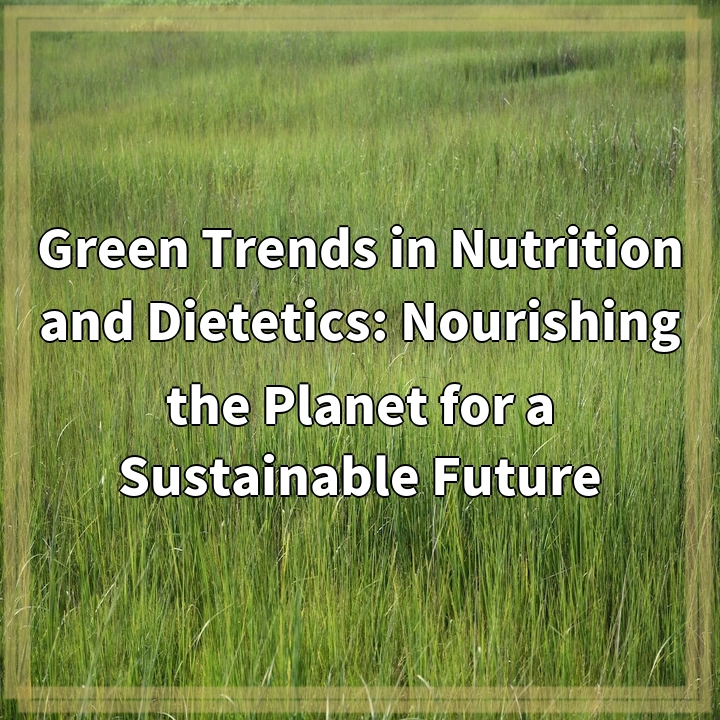
What It Is
Green trends in nutrition and dietetics refer to the growing movement towards sustainable food choices that prioritize the health of individuals and the planet. This approach recognizes the interconnectedness of our food systems and the environmental impact of our dietary habits. By adopting green practices in nutrition and dietetics, we can work towards nourishing ourselves while minimizing harm to the environment.
Real-World Problems
1. Food Waste
One of the major challenges we face is food waste. According to the Food and Agriculture Organization of the United Nations, approximately one-third of all food produced for human consumption is lost or wasted. This not only puts a strain on natural resources but also contributes to greenhouse gas emissions. Green trends in nutrition and dietetics focus on reducing food waste by promoting mindful consumption, proper storage, and creative use of leftovers.
2. Unsustainable Agriculture
Many conventional agricultural practices have a detrimental impact on the environment. Pesticides, synthetic fertilizers, and intensive irrigation contribute to soil erosion, water pollution, and biodiversity loss. Green trends in nutrition and dietetics emphasize the importance of supporting sustainable agriculture methods such as organic farming, regenerative agriculture, and permaculture. These practices prioritize soil health, water conservation, and ecosystem preservation.
3. Deforestation and Land Degradation
The expansion of agricultural land, particularly for livestock production, has led to deforestation and land degradation in many parts of the world. This not only threatens wildlife habitats but also exacerbates climate change by releasing carbon stored in forests. Green trends in nutrition and dietetics advocate for reducing reliance on animal products and promoting plant-based and alternative protein sources. By shifting towards more plant-centric diets, we can help mitigate deforestation and reduce land degradation.
4. Climate Change Impact
The food industry is a significant contributor to greenhouse gas emissions, mainly through the production, processing, and transportation of food. The livestock sector, in particular, produces large amounts of methane, a potent greenhouse gas. Green trends in nutrition and dietetics highlight the importance of adopting low-carbon food choices, such as plant-based diets and locally sourced foods. By reducing our carbon footprint through dietary changes, we can contribute to mitigating climate change.
5. Health Implications
Traditional Western diets, high in processed foods, unhealthy fats, and added sugars, have been linked to various health problems, including obesity, heart disease, and diabetes. Green trends in nutrition and dietetics emphasize the need for nutrient-rich, whole foods that support both human and environmental health. By prioritizing fresh, locally sourced, and organic produce, we can improve our own well-being while promoting sustainable farming practices.
In summary, green trends in nutrition and dietetics recognize the urgent need to transition towards sustainable food systems that prioritize environmental stewardship and human health. By addressing issues such as food waste, unsustainable agriculture, deforestation, climate change, and health implications, we can contribute to a more sustainable and resilient future.

Solutions for Green Trends in Nutrition and Dietetics
1. Reducing Food Waste
To address the issue of food waste, individuals can practice mindful consumption, proper storage, and creative use of leftovers. This includes planning meals, buying only what is needed, properly storing food to extend its shelf life, and finding innovative ways to repurpose surplus food.
2. Supporting Sustainable Agriculture
To promote sustainable agricultural practices, individuals can choose to support organic farming, regenerative agriculture, and permaculture. These methods prioritize soil health, water conservation, and ecosystem preservation. Additionally, supporting local farmers and buying seasonal produce helps reduce the environmental impact of food transportation.
3. Shifting Towards Plant-Centric Diets
To address deforestation, land degradation, and climate change, individuals can reduce their reliance on animal products and adopt plant-centric diets. This involves incorporating more fruits, vegetables, whole grains, legumes, and alternative protein sources into daily meals. Plant-based diets have a lower carbon footprint and can help mitigate deforestation associated with livestock farming.
4. Choosing Low-Carbon Food Choices
To mitigate the impact of the food industry on climate change, individuals can make low-carbon food choices. This includes opting for locally sourced foods, supporting sustainable seafood options, and reducing the consumption of carbon-intensive products like processed foods and beverages. By making these choices, we can reduce greenhouse gas emissions and contribute to climate change mitigation.
5. Prioritizing Nutrient-Rich, Whole Foods
To address health implications, individuals can prioritize nutrient-rich, whole foods in their diets. This includes consuming fresh, locally sourced, and organic produce. By making these choices, we can improve our own well-being and support sustainable farming practices that prioritize human and environmental health.
In conclusion, addressing the real-world problems associated with green trends in nutrition and dietetics requires individual actions and choices. By reducing food waste, supporting sustainable agriculture, shifting towards plant-centric diets, choosing low-carbon food choices, and prioritizing nutrient-rich, whole foods, we can contribute to a more sustainable and nourishing future for both ourselves and the planet.















